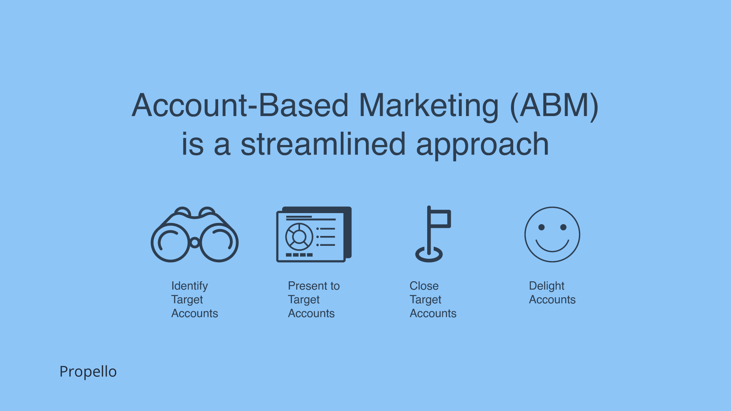Are you tired of hearing how account-based marketing (ABM) is the future of B2B marketing? Do you want to learn why ABM works so well?
In this article, we'll explain why ABM is the most effective way to reach prospects and close deals. We'll also share with you the benefits of ABM and how it will help you build stronger relationships with your customers.
If you've never heard of ABM before, then you should read the Ultimate Guide to ABM. It explains everything you need to know about ABM and why it's the most powerful form of marketing available today.
|
Account-Based Marketing Account-based marketing (ABM) is a focused growth strategy in which Marketing and Sales collaborate to create personalized buying experiences for a mutually-identified set of high-value accounts. |
Are you tired of hearing how account-based marketing (ABM) is the future of B2B marketing? Do you want to learn why ABM works so well?
In this article, we'll explain why ABM is the most effective way to reach prospects and close deals. We'll also share with you the benefits of ABM and how it will help you build stronger relationships with your customers.
If you've never heard of ABM before, then you should read the Ultimate Guide to ABM. It explains everything you need to know about ABM and why it's the most powerful form of marketing available today.
What is account-based marketing (ABM)?
Account-Based Marketing (ABM) is an approach to marketing where you focus your efforts on a particular group of customers (target accounts) or prospects rather than trying to reach everyone indiscriminately.
It uses customized campaigns designed to reach each customer, based on their unique characteristics and needs. This allows you to put more effort into those relationships and make sure you are delivering what they want.
ABM also looks at marketing from a broader perspective than just lead generation. Upselling and cross-selling to the existing customer account are one of the keys to getting the most value out of your biggest clients.
The concept of ABM is simple. You identify the best customers for your products or services and then use data about those customers to build targeted campaigns. In doing so, you can deliver high-quality messages to people who are likely to buy from you. And since you know exactly who you are targeting, you can tailor your messaging specifically to their individual needs.
Who Uses Account-Based Marketing?
Many different industries have adopted this strategy. Some of the largest include:
- Financial Services – Banks, credit unions, insurance companies, mortgage brokers, etc.
- Healthcare – Hospitals, medical practices, pharmaceuticals, health plans, etc.
- Retail – Retailers, grocery stores, department stores, etc.
- Telecommunications – Telecom providers, cable TV, cell phone carriers, etc.
- Technology – Software developers, web design firms, IT consultants, etc.
New hires shouldn't start their onboarding processes without first listening to a variety of different model training sessions to learn and practice from them. Call scripts or call monologues could be utilized alongside these pieces of training.
How Account-Based Marketing & Inbound Marketing Work Together
Inbound and account-based marketing are often used interchangeably, but there’s a difference between them.
ABM is about reaching out to potential leads and prospects. This could include cold calling, emailing, social media posts, etc. Inbound marketing, on the other hand, is about creating great content that people want to consume. This includes blog articles, case studies, infographics, etc.
ABM is one form of outbound marketing that uses data to identify your ideal customer profiles (ICPs). Once you find those ICPs, you can use them to select the best accounts to reach out to. You might start with smaller accounts, and work your way up to larger ones over time.
Combining both inbound and outbound methods in your overall marketing plan is an extremely effective way to drive traffic to your site. Inbound marketing can also help you find these dream clients. To use a fishing metaphor, once you've caught some high-quality prospects in your inbound net, you can then target them with an ABM spear.
The key to success here is finding the right balance between inbound and outbound. Too much outbound and you won’t have enough qualified leads to nurture. Too much inbound and you risk losing sight of what makes each account special.
When you combine inbound marketing and ABM, three things occur:
- With every inbound effort, you get more data to help you create more detailed buyer personas and ICP profiles to be used in your ABM strategy
- You have more bandwidth than most companies to create an on-brand experience that sets you apart from the rest of the market.
- Your content creation strategy can often be tailored to specific audiences within your ABM accounts, meaning you don't need to create new content every time.
Benefits of an Account-Based Marketing strategy
Account-based marketing can deliver numerous benefits to a business. Recent studies have shown the benefits of using ABM tactics:
- A study by Demandbase found that 19% of companies using ABM for at least a year reported more than 30% growth in revenue.
- A SiriusDecisions survey found that 91% of marketers using ABM see a larger deal size, with 25% seeing their deal sizes grow by more than 50%.
- 85% of marketers who measure ROI describe account-based marketing as delivering higher returns than any other marketing approach.
Here are some of the top benefits of Account-based marketing:
1. Keeps marketing and sales aligned
Collaborating across teams and communicating effectively within an organization are both important for growth. About account-based marketing, this transparency and alignment will ensure your marketing and sales teams' focus is aligned, they stick to the mutually agreed-upon budget, and understand their specific role within the company.
This alignment ensures that all communication, interactions, and content across your accounts are consistent. Meaning, even if an account has been working for your business for a long period, your employees can pick up where others leave off at any point in the future without questioning whether they're doing things correctly. This creates a seamless and delightful customer experience.
To keep your internal team aligned, use software like HubSpot, which allows you to connect your sales and customer service teams easily.
2. Streamline the sales cycle
ABM streamlines the sales process by allowing you to communicate directly with customers based on their needs and interests. It's not just about selling; it's about building relationships and understanding how best to serve your audience.
Depending on your type of company and industry, the sales process usually goes through these steps:
1) Prospect → 2) Connect → 3) Research → 4) Present → 5) Close → 6) Delight
Account-based marketing (ABM) is an effective way to generate leads for your business. Focusing your energies on specific high-value target accounts allows you to focus your time and resources on the parts of the sales cycle that positively affect your bottom lines:
1) Identify Target Accounts → 2) Present to Target Accounts → 3) Close Target Accounts → 4) Delight Accounts

3. Deliver consistent customer experiences
ABM makes sure everyone knows which accounts are at different stages of the buying cycle and then ensures that every member of the sales and marketing teams delivers personalized and timely communications, campaigns, products, and price points for each stage.
To create an amazing ABM strategy, you need to keep a long-term sense of delight among your accounts. Every single one of them should be treated as if they were your company's target audience. You achieve this by providing consistent, delightful experiences.
ABM is a marketing strategy that requires major alignment among sales and marketing teams. So be sure to focus on that when working to create those consistent customer journeys.
4. Measures your return on investment
Account-Based Marketing (ABM) is one of the most effective ways to grow your brand online. But it takes careful planning and execution to make sure you are getting the best ROI possible.
Account-based marketing allows you to easily measure ROI for each account you spend your resources and time on. It’s helpful because you can prove which ones worked best for your business.
After that, you can continue nurturing and delighting those accounts for a longer period to keep them, as well as identify and target similar accounts in the near term. If your ROI shows that your ABM tactics were successful, then you can leverage that data to improve your strategy.
5. Increased Efficiency
With ABM, you can automate your entire account-based marketing campaign so that you don't need to manually manage each account. You can scale your efforts across multiple campaigns, allowing your team to focus their attention on high-value accounts rather than low-value ones.
For example, automating media buys, ad targeting, modeling, and upselling makes them much more efficient.
ABM also helps increase efficiency by narrowing down which accounts to focus on (highest ROI). When an ABM campaign reaches a certain point where it isn't generating enough leads for your business anymore, you simply remove it from your list of campaigns.
Time and money are your two most important resources, and they're best spent by using them for their intended purpose—to grow your business.
6. Shorter Customer Lifecycles
ABM helps speed up the entire buying cycle by eliminating unqualified leads at an early stage. Marketing and selling teams can then concentrate their efforts on the highest-value opportunities and provide them with the most personalized experience.
The collaboration of teams to move customers down the funnel smoothly usually shortens the customer lifecycle. Companies that collaborate across departments and functions spend less time closing deals and more time nurturing relationships.
If you target your messages appropriately throughout the entire customer journey, you'll significantly reduce the time it takes for them to decide whether or not to buy from you.
In B2B, the buyers are often multiple people. They are not just individuals, but boards of stakeholders who all need access to the same information to make a final decision. And here lies another advantage of account-based marketing: it targets whole accounts. So, even though you might have several contacts within an organization, you still target the entire organization.
Once the time comes for a choice to be made, the entire account has already been introduced to your brand and is already part of the conversation. This can shorten the sales cycle considerably and speed up the sales process.
7. Building and Nurturing Relationships
In ABM, you should always strive to establish relationships with the key contacts within your target accounts. These relationships will help you build trust with them and give you a deeper understanding of their needs and wants. Once you've established these relationships, you'll be able to personalize your content and messaging to meet their specific needs and desires.
You will learn about their behavior patterns and will be able to respond quickly to their needs. You will be asked to provide advice on the challenges that they're facing.
You should collect as much information as possible about your customers throughout the relationship. This information will help you plan and implement future ABM campaigns effectively.
8. Well-Optimized Funnel
Traditional lead gen funnels are broad at the top and narrower at the bottom. Marketing departments are responsible for the top of these funnels, and sales teams are responsible for the bottom.
To ensure there are enough opportunities for the sales team to close deals, your marketing department needs to focus on feeding as many leads into the funnel as possible. The number who reach the end of the funnel will be far fewer than the number who enter it.
Account-based marketing changes that. Marketing and sales work hand in hand. Every stage of the customer journey must be optimized to deliver a personalized and relevant experience.
Marketing and Sales collaborate to ensure that every prospective customer entering the sales cycle is highly qualified and that their needs can be accurately met at any point in the buying journey.
9. Improved Engagement
It's not always easy to create content that is engaging and entertaining for your customers. With account-based marketing, your content is tailored to meet the specific requirements of your clients and to offer them actionable solutions to their particular issues.
Focusing on specific clients allows you to optimize your content creation efforts for each client. If you provide good service, high-level content, and expertise, then your customers will naturally become more engaged. You're not just giving them something for free; you're providing them with exactly what they want.
10. Increased ROI
With account-based marketing, you're targeting the right audience at the right time. That means you're going after the most valuable prospects first. As a result, you get better results faster.
The best way to measure the success of your ABM campaign is to look at how well you're converting the new business from existing customers. When you convert those leads into actual revenue, you know you're doing things right.
Grow with ABM
ABM is an effective tool for growing your business. It helps you identify and engage with the right people at the right time. And when you do so, you increase the likelihood of closing deals and achieving your goals.
The main idea behind ABM is that it allows companies to build stronger customer relationships by focusing on their existing clients rather than trying to reach out to new ones. By doing this, companies can gain valuable insights into their current client base and use these findings to improve future interactions with them.
ABM has been proven to generate higher conversion rates and lower costs compared to traditional methods. Learn more from our Ultimate Guide to Account-based Marketing.
At Fine media, we help businesses build relationships with customers through personalized marketing campaigns. We have developed a unique approach to account-based marketing (ABM), which leverages data science and machine learning to drive real engagement between brands and consumers.
Our team of inbound marketing experts will work with you to develop a strategy that aligns with your brand’s objectives. Our goal is to help you grow your business using digital marketing techniques that are both cost-effective and scalable.
We believe that successful marketing strategies should be based on solid research and analytics. This is why we focus on understanding your target market and developing a plan that delivers measurable results.



